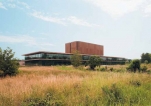Building that Breathes Life

In the Netherlands are used to adhere to strict building codes. Legislation, permits and schedules of requirements dictate how a building should be constructed. The new main building of the Netherlands Institute of Ecology (NIOO) currently under construction in Wageningen, however, is taking a very different approach. The process being applied here does not follow the standard A to B route – from schedule of requirements to final product, from drawing board to bricks. No, this process can best be described as ‘evolutionary’. The office cum laboratory currently under construction will serve as a testing ground for eco-technology systems, where innovation and experimentation are given room to grow not only during the design phase, but also during the construction and completion phases. The Netherlands Institute of Ecology, one of the research institutes of the Royal Netherlands Academy of Arts and Sciences (KNAW), studies the effect of nature in all its many forms. It is, therefore, only fitting that ecological processes and the dynamics of nature themselves now influence the design and construction of their new premises. The brief was to design a building that is comfortable and functional but that also blends into the surrounding environs. With vision, creativity and perseverance, anything is possible.
CRADLE TO CRADLE
Some years ago, NIOO decided to merge activities from two of its locations into one new sustainable building. NIOO director, Professor Louise Vet, was inspired by the Cradle to Cradle (C2C) principles and wanted to take the design and construction of their building one step further than the most sustainable buildings built to date in the Netherlands. Sustainability is generally measured by energy efficiency; the C2C concept, however, poses new criteria. The question is not what can be done to limit environmental damage, but rather how can be made a valuable contribution to the surrounding environment?
The C2C guiding principle is that production should be waste free. In the cradle to cradle model, everything we make and leave behind is regenerated as raw materials for use in the natural environment or in new products. The other two main principles are: use solar energy and celebrate biodiversity. The designers were instructed to keep as close to this philosophy as possible.
PROCESS
NIOO-KNAW did not restrict its choice of architect and construction company to what you might term ‘green’ parties. Involving mainstream architects and builders in the process has a significant social impact. “You widen the circle of expertise and set an inspiring example for others.” The design of a ‘smart’ building, one that is light and airy, ergonomic, easy to navigate and innovative in sustainable solutions was created by a diverse design team. It got down to work, employing an approach that combined learning as you go along and implementing what you have learnt.
Having clarified the design brief, the next stage was to tackle the construction process, which posed a new set of questions and sparked fresh discussions. Not least of all from those commissioning the building. Which materials should be used, what kind of flooring, how to generate energy, how should be closed the wastewater circuit, and what to do with the residual heat?
The majority of the parties involved in this process are keen to expand and strengthen their expertise in sustainability, which often gives rise to inspiring exchanges of ideas and solutions. All the parties come together in a workgroup to coordinate communication on the design and construction.
Full content of this issue you can read here
The full version of the article can be read in our printed issue, also you can subscribe to the web-version of the magazine
 Materials provided by Felix Claus Dick van Wageningen Architecten
Materials provided by Felix Claus Dick van Wageningen Architecten
Photos: Sebastian van Damme


